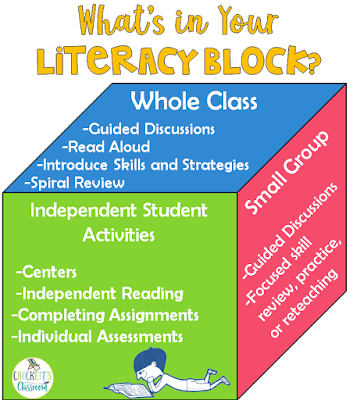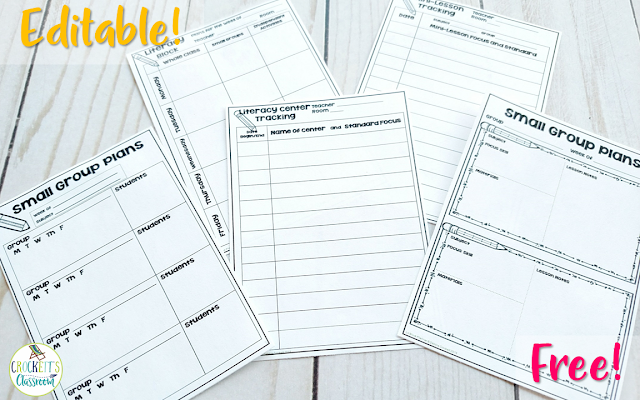Literacy Block, What’s in it?
This is by far, the most important (and my favorite) part of my day. I love all aspects of teaching reading, from our whole class lessons down to individual conferences. The literacy block will look a little different in everyone’s classroom. I’d like to share how it looks in my classroom. My literacy block has three main parts: whole class instruction, small group instruction, and independent students activities. All three are important and all three were part of my daily literacy block in some way.
During whole class lessons, every student is engaged in the same activity. This is the time when new strategies or skills are introduced. Every student is hearing the same information at the same time. Whole class lessons set the foundation for small group and individual student activities. You could call this time the starting block for your reading instruction. Here’s what can be included in your whole class instruction time:
-Guided Discussions: The text could be a story from a reading anthology or textbook, a literature study, or informational text. You don’t need a copy of the text for every student. Sometimes I had one text for every two students. At other times my lesson had one text that could be seen by all students, such as a big book or a text projected on a whiteboard. Like the heading says, the teacher guides the discussion, based on the reading skill or strategy focus for the day.
-Read Aloud : It’s no secret that this is my very, very, very favorite part of the day. This is one whole class activity that I do every day! It’s not only a great bonding time with your kids, you can do so much instruction when reading aloud to your students.
-Introduce new skills or strategies: Introducing new skills and strategies is something I always do during whole class lessons. I want to make sure that all of my students, no matter their reading level, heard the same information at the same time. The practicing, reviewing and reteaching of the skills and strategies might happen during small groups and individual student activities.
-Spiral Review of skills: Throughout the year I made sure to review previously taught skills and strategies. The skills can be directly reviewed with an activity or it could be incorporated in the guided discussion.
Small Group Instruction
Fountas and Pinnell, in the book Guiding Readers and Writers in grades 3-6, called this time Guided Reading. They described it best with this statement:
“In guided reading, you bring together groups of students who are similar in their reading behavior, their text-processing needs, and their reading strengths. Your instruction, then, is specific and focused, finely tuned to the needs and challenges of the particular group of students with whom you are working.” In other words, small groups are when you can have focused lessons to meet the needs of a specific group of readers.
Here’s what can be included in small group instruction:
-Guided Discussions: Once again the text can be from the class reading textbook, a literature study, or informational text. Another common source is the ancillary books often included with a reading series.
- Focused skill review, reteaching, or practice: Small groups are formed with a specific purpose in mind. It might be to reteach a skill the students haven’t mastered. It might be to practice a skill presented in a whole group lesson. Review is also important to make sure the students are continuing to use previously taught skills and strategies.
Bonus! I've put together a few planning pages to help you keep track of your small group lessons, mini-lessons, and centers. Click on the image to get this goodie!
Bonus! I've put together a few planning pages to help you keep track of your small group lessons, mini-lessons, and centers. Click on the image to get this goodie!
Independent Student Activities
The third instructional time is when students work on tasks, without the teacher. These activities happen when the teacher is working with small groups or conferencing with individual students. The students are engaged in tasks that review and practice skills and strategies that have been presented in either whole class or small group lessons. These independent activities may have students working on their own, with partners or in small groups. Options for independent activities:
-Literacy Centers: Centers are the most common way to have students work independently. The centers have hands-on activities or games that focus on previously taught skills and strategies. They may cover reading comprehension, phonics, word study, grammar, fluency, or any other literacy area.
- Independent Reading: Students need time to read books at their independent reading level. These books can be self-selected or assigned by the teacher. For accountability, journals are a good way for students to write about their reading.
-Completing Assignments: After whole class or small group lessons, students will often need time to complete any written or reading task that has been assigned.
-Assessments or Progress Monitoring: This is the only activity that involves the teacher. I put it in this category because it is done with individual students. Throughout the year, student achievement will need to be assessed on an individual basis.
This is only a broad overview of what I include in the part of my instructional day I call the "literacy block" The time I spend on each piece of this block varies from week to week, even day to day. If I have a 90-minute block of time, I generally divide the time into thirds. In the next few months, I'll be sharing more ideas about the literacy block.



















No comments
Post a Comment